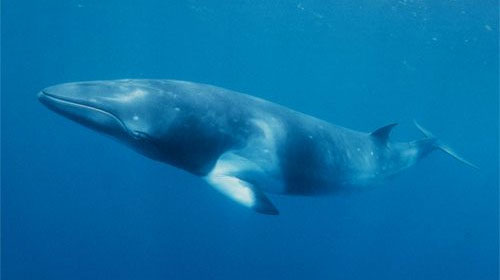Fin whale
The Fin whale is the second largest creature on our planet and is only beaten by its close relative the blue whale. these massive whales are found in all of the worlds oceans and can swim at speeds of up to 40km per hour. The Fin whale is sadly classed as endangered today due to mass whale hunting. The estimated figures for the Fin whale were around 470,000 which is though to have declined to around 55,000 in the world today.
There is no preferred habitat as such for these wonderful animals. The Fin whale can be found in all of the worlds oceans however they are less likely to be seen in tropical waters and polar waters – they can even be found in shallow coastal water.
The Fin whale gets its name from its large dorsal fin which can reach up to and around 60cm in length. Second to only the blue whale in size the Fin whale can reach a length of around 28 meters and and can be distinguished from its relative, the blue whale, by its coloration which is predominantly gray with a lighter underside.

The massive Fin whale in action
Other distinguishing characteristics of the Fin whale are its slightly pointed nose and a relatively slender body compared to the blue whale. The Fin whale also has grooves that run along its underside from its jaw to its lower areas. There is no easy way to distinguish sex in the Fin whale’s however the females of the species tend to be larger on average.
The Fin whale’s migrate closer to the equator during spring and summer when most feeding takes place. Like other species of whale the Fin whale feeds by swallowing prey and water whole which is filtered through the Fin whale’s baleen plates and excess water is almost immediately ejected through the grooves on the underside of the Fin whale. Curiously the Fin whale’s have been known to approach schools of fish on their sides with the right side facing down, this is thought to be done because the right side of the Fin whale’s face is usually darker in color compared to the left side.
Fin whale’s migrate away from the equator during autumn and winter and its in this period where breeding and raising the young takes place. Generally Fin whale’s are usually seen alone or in pairs however they are usually part of a group of a round 6 or 7 that are in turn often part of a much larger group.
With an estimated lifespan of around 80 years the Fin whale’s reach sexual maturity around the age of 8 years on average. After successful mating the female Fin whale will endure a gestation period of around 1 year before giving birth and this cycle usually repeats every 2 or 3 years.



thats not a fin whale its a minke whale if u know so much then how come u dont even know what they look like
that is a fin whale because it is so much longer an minke whales are smaller but they do have the sam color so i see how u would get that mixed up
same*